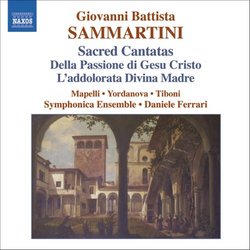| All Artists: Giovanni Battista Sammartini, Daniele Ferrari, Symphonica Ensemble, Filippo Ravizza, Miroslava Yordanova, Silvia Mapelli, Giorgio Tiboni Title: Giovanni Battista Sammartini: Sacred Cantatas Members Wishing: 0 Total Copies: 0 Label: Naxos Original Release Date: 1/1/2006 Re-Release Date: 11/21/2006 Genres: Pop, Classical Styles: Vocal Pop, Opera & Classical Vocal, Historical Periods, Classical (c.1770-1830) Number of Discs: 1 SwapaCD Credits: 1 UPC: 747313025473 |
Search - Giovanni Battista Sammartini, Daniele Ferrari, Symphonica Ensemble :: Giovanni Battista Sammartini: Sacred Cantatas
 | Giovanni Battista Sammartini, Daniele Ferrari, Symphonica Ensemble Giovanni Battista Sammartini: Sacred Cantatas Genres: Pop, Classical
|
Larger Image |
CD Details |
CD ReviewsWorld Premiere Recording - but why such 'reversed' choice of Abel | Hong Kong | 02/25/2010 (5 out of 5 stars) "The Passion of Christ followed by the weeping Mary form the main bulk of this recording, which according to Naxos, is the world premiere recording of these works.
The ensemble is a strong one, Ferrari being the champion of Sammartini's works in the modern era. The three soloists are baroque experts, and the sonics of the performances are very fine by Naxos. Nothing smacks of a 'budgetary item'. GB Sammartini is not as popular a composer as his other counterparts in the baroque era. And you would not take long to understand why - his arias, though very fine, are generally more lengthy than JS Bach, GF Handel, or A Vivaldi's - lengthy in the sense that they are quite repetitive. The soloists here did not employ different da capo treatment to the arias. So you would have to be more patient than with other baroque compositions of the same genre. Otherwise, I would say that these are wonderful works and impeccably performed. The roles of the characters were taken in 'reverse' order - female singers singing male roles, while tenor singing a female role. I do not understand why; not even after reading the liner notes. May be Sammartini wanted it that way, but even if the male roles were meant for castrati singers, what about the female role? Why was a tenor employed?" |

 Track Listings (18) - Disc #1
Track Listings (18) - Disc #1